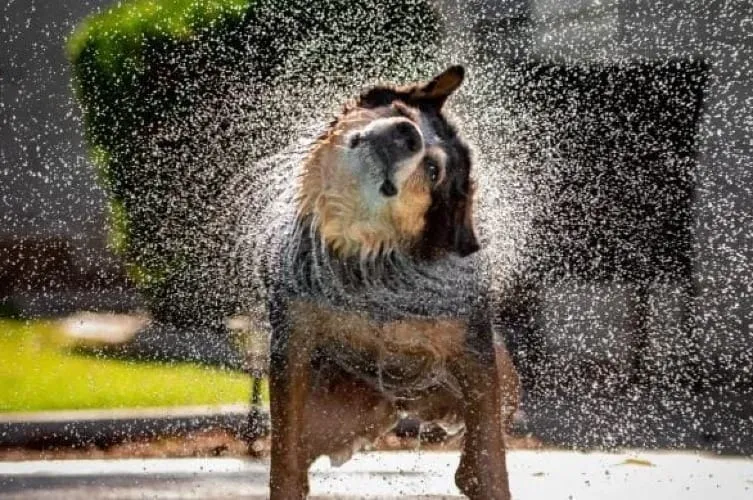Dogs are known for their expressive body language, and one of the most common behaviors they exhibit is shaking their bodies. This behavior can occur at various times and for various reasons, but one of the most common instances is after being petted. Many dog owners have likely experienced this phenomenon and may wonder why their furry friend feels the need to shake it off.

One theory for why dogs shake after being petted is that it is a way for them to release tension and excitement. When a dog is being petted, they may become overstimulated and feel a surge of energy. Shaking their body could be a way for them to release this pent-up energy and calm themselves down. Additionally, dogs may shake to signal to their owner that they are ready to move on from the interaction and engage in other activities.
Another possible explanation for why dogs shake after being petted is that it is a way for them to spread their scent. Dogs have scent glands located throughout their bodies, and shaking can help to distribute these scents. By spreading their scent, dogs are able to mark their territory and communicate with other dogs in the area.
Understanding Canine Body Language
Dogs communicate in various ways, and one of the most common ways is through body language. Understanding their body language can help you better understand your furry friend's needs and emotions. One of the most common behaviors that dogs exhibit is shaking their bodies, and this can mean different things depending on the context.
Communication Through Shaking
Dogs shake their bodies to communicate with other dogs or humans. When dogs meet each other, they often shake their bodies as a way of saying "hello" or "let's play." Similarly, when you pet your dog, they may shake their body as a way of communicating with you. This can be a sign that they are enjoying your attention and want more.

Signs of Stress and Anxiety
While shaking can be a sign of joy and excitement, it can also be a sign of stress and anxiety. If your dog is shaking excessively, this may be a sign that they are feeling tense or anxious. This can be caused by various factors such as loud noises, unfamiliar surroundings, or separation anxiety. If you notice your dog shaking excessively, it's best to consult with a veterinarian to rule out any underlying medical conditions.
Shaking as a Sign of Joy and Excitement
In many cases, shaking is a sign of joy and excitement. Dogs may shake their bodies when they are happy and excited, such as when you come home from work or when they see their favorite toy. This is often accompanied by other signs of happiness, such as wagging their tail, jumping, or licking.
Understanding your dog's body language can help you better communicate with them and strengthen your bond. By paying attention to their behavior and the context in which they shake their bodies, you can better understand their needs and emotions.

Health and Behavioral Reasons for Shaking
Dogs are known to shake their bodies after being petted or when they are excited. While this behavior is often harmless, it can sometimes indicate underlying health or behavioral issues. In this section, we will explore the common reasons why dogs shake their bodies.
Common Health Issues Leading to Shaking
Shaking can be a symptom of various health issues that affect dogs. Some of the most common health problems that can cause shaking include ear infections, pain, discomfort, fear, seizures, and illness. Dogs may also shake due to infections and diseases that affect their nervous system.
Behavioral Responses and Shaking
Dogs may also shake their bodies due to behavioral responses. For instance, they may shake when they are excited, anxious, or stressed. Some dogs may even shake when they are happy or anticipating something good. This behavior is often harmless and does not require any medical attention.
When to Consult a Veterinarian
While shaking is often harmless, it can sometimes indicate an underlying health issue that requires medical attention. Pet owners should consult a veterinarian if their dog is shaking excessively or if they notice other symptoms such as lethargy, loss of appetite, or vomiting. A vet can examine the dog and perform tests to determine the underlying cause of the shaking.
In conclusion, dogs may shake their bodies due to various health and behavioral reasons. While some shaking is harmless, pet owners should monitor their dogs and consult a veterinarian if they notice any concerning symptoms. By understanding the reasons why dogs shake, pet owners can better care for their furry friends and ensure their overall well-being.

Physical Triggers and Environmental Factors
Dogs shaking their bodies after being petted is a common behavior that can have various physical triggers and environmental factors. Understanding these triggers can help pet owners better understand their dogs' behavior and needs.
Shaking Off Water or Debris
One of the most common reasons why dogs shake their bodies is to get rid of water or debris on their fur. This behavior is especially prevalent in breeds that were originally bred for water activities, such as retrievers and spaniels. Dogs have a natural instinct to shake off water, which helps them dry off quickly and prevent skin irritation caused by wet fur.
Response to Cold or Wet Conditions
Dogs may also shake their bodies as a response to cold or wet conditions. Shaking helps to generate body heat and restore circulation, which can be especially important in colder environments. Additionally, shaking can help to remove any moisture that may have accumulated on the fur, preventing skin irritation and other issues.
Influence of Breed on Shaking Behavior
The frequency and intensity of shaking behavior can also vary depending on the breed of dog. Breeds with thick fur, such as huskies and chows, may shake more frequently to cool down and remove debris from their fur. On the other hand, breeds with shorter fur, such as boxers and bulldogs, may shake less frequently.
In summary, dogs shake their bodies for various physical triggers and environmental factors, including getting rid of water or debris, responding to cold or wet conditions, and breed-specific behavior. Understanding these triggers can help pet owners better care for their dogs and ensure their comfort and well-being.

Shaking as Part of Normal Dog Activities
Dogs often shake their bodies after being petted, but it's not the only reason they do it. Shaking is a natural behavior in dogs and is part of their normal activities. Here are some reasons why dogs shake:
Stretching and Shaking After Sleep
Just like humans, dogs need to stretch and shake their bodies after a nap or a good night's sleep. This helps to wake up their muscles and increase blood flow, which can make them feel more alert and energized.
Post-Play Session Shaking
Dogs love to play, and after a vigorous play session, they may shake their bodies to release pent-up energy and tension. This is a natural instinct in dogs and helps them to relieve stress and relax.
Shaking to Release Tension or Energy
Dogs may also shake their bodies to release tension or energy, especially if they are feeling anxious or excited. This behavior is often seen in dogs that are about to go for a walk or are anticipating a fun activity.
In conclusion, shaking is a natural behavior in dogs and is part of their normal activities. It's important to understand that dogs shake for various reasons, and it's not always a sign of discomfort or stress. By observing their body language and behavior, you can better understand your dog's needs and provide them with the care and attention they deserve.

Addressing Excessive or Problematic Shaking
Dogs may shake their bodies after being petted to relieve tension or simply because it feels good. However, excessive or abnormal shaking may indicate an underlying issue that requires attention. In this section, we will discuss how to identify abnormal shaking patterns, interventions for excessive shaking, and preventive measures and care.
Identifying Abnormal Shaking Patterns
Abnormal shaking patterns may include trembling, head shaking, or shivering, and may be accompanied by itching, irritation, inflammation, or ear infection. Poisoning, hypoglycemia, generalized tremor syndrome, canine distemper, and toxins can also cause abnormal shaking in dogs. Senior dogs may experience shaking due to age-related issues such as arthritis or cognitive dysfunction.
If your dog is exhibiting excessive or abnormal shaking, it is important to consult with a veterinarian to determine the underlying cause and appropriate treatment.
Interventions for Excessive Shaking
Interventions for excessive shaking will depend on the underlying cause. For example, if the shaking is due to low blood sugar, feeding your dog a small meal may help. If the shaking is due to anxiety or fear, an animal behaviorist may be able to provide guidance on how to modify your dog's behavior. Medications may also be prescribed to manage underlying medical conditions.
Preventive Measures and Care
Preventive measures and care can help reduce the likelihood of excessive or abnormal shaking in dogs. Providing regular exercise and mental stimulation can help reduce stress and anxiety. Avoiding exposure to toxins such as chocolate and household chemicals is also important. Regular check-ups with a veterinarian can help identify and address any underlying medical issues before they progress.
In summary, while shaking after being petted is a normal behavior in dogs, excessive or abnormal shaking may indicate an underlying issue that requires attention. Identifying abnormal shaking patterns, interventions for excessive shaking, and preventive measures and care can help ensure your dog remains healthy and happy.
Conclusion
In conclusion, the act of dogs shaking their bodies encompasses a wide spectrum of meanings and is influenced by various factors including emotional states, physical triggers, and environmental conditions. While shaking can be a normal and harmless behavior reflecting excitement, joy, or the need to release tension, it can also serve as a communication tool or a method for spreading scent.
Importantly, understanding canine body language, such as shaking, is crucial for pet owners to better interpret their dog's needs and emotions, ultimately enhancing the bond between them. However, it's essential to remain vigilant for excessive or abnormal shaking patterns, which could signal underlying health or behavioral issues requiring professional consultation. By paying attention to the context and frequency of shaking, providing regular care, and consulting a veterinarian when necessary, pet owners can ensure the well-being and happiness of their furry companions.




